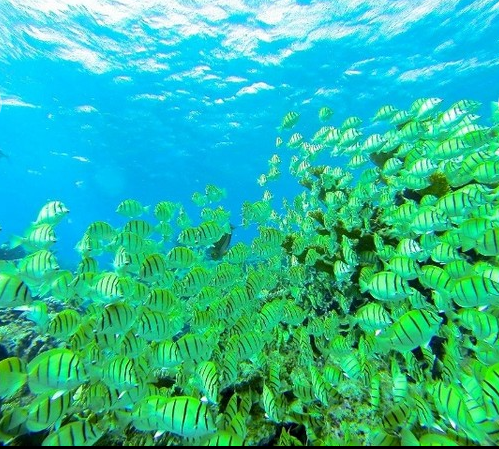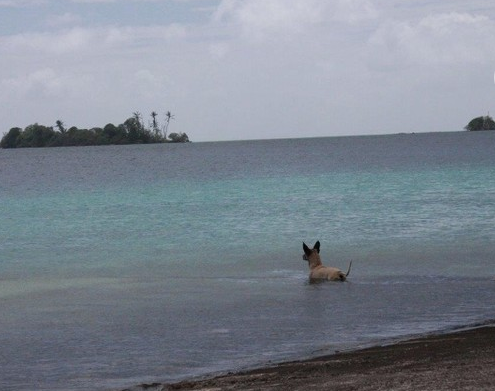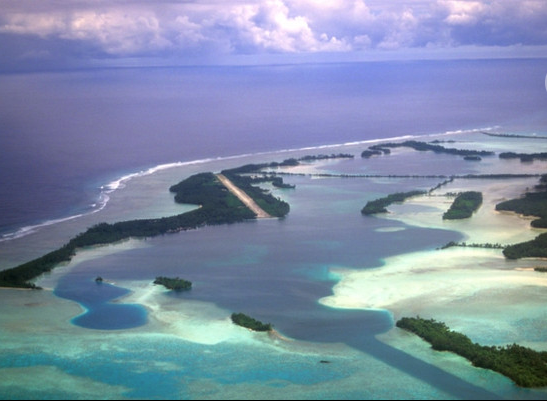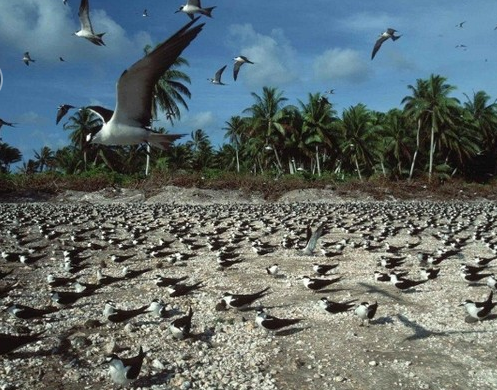About halfway between Hawaii and American Samoa in the middle of the Pacific Ocean lies a string of pearls call the Palmyra Atoll, a place where sharks outnumber people. Palmyra Atoll is an unoccupied equatorial Northern Pacific atoll administered as an unorganized incorporated territory by the United States federal government. The variable temporary population are staff and scientists employed by various departments of the US government and The Nature Conservancy, as well as a rotating mix of Palmyra Atoll Research Consortium scholars pursuing research.
Palmyra is one of the Northern Line Islands (southeast of Kingman Reef and north of Kiribati Line Islands), located almost due south of the Hawaiian Islands, roughly halfway between Hawaii and American Samoa. For the last 18 years or so, a special dog has made this place his home where he spends his days hunting sharks and entertaining scientists from around the world.
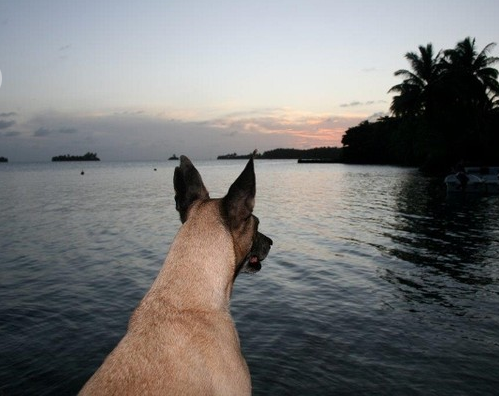 Consisting of a ring of some 50 islets and 15,000 acres of shallow and submerged reefs, Palmyra is one of the United States’ best kept secrets. Referred to as an atoll because it is not quite large enough to be called an island, Palmyra has a long and colorful history, including use as a Naval base during World War II. In 1898, President McKinley annexed the atoll as part of the Territory of Hawaii, but for some reason lost to history it was not included when Hawaii became a state in 1959. The atoll was sold to the Fullard-Leo family for $15,000 back in 1922. Half-private, half government property, the atoll was in legal limbo until The Nature Conservancy purchased it from the family for $30 million in 2000. In 2009, Palmyra became part of the Pacific Remote Islands Marine National Monument. Now the atoll is part wildlife and coral reef reserve and part science lab with visits year around by those who study Pacific marine life.
Consisting of a ring of some 50 islets and 15,000 acres of shallow and submerged reefs, Palmyra is one of the United States’ best kept secrets. Referred to as an atoll because it is not quite large enough to be called an island, Palmyra has a long and colorful history, including use as a Naval base during World War II. In 1898, President McKinley annexed the atoll as part of the Territory of Hawaii, but for some reason lost to history it was not included when Hawaii became a state in 1959. The atoll was sold to the Fullard-Leo family for $15,000 back in 1922. Half-private, half government property, the atoll was in legal limbo until The Nature Conservancy purchased it from the family for $30 million in 2000. In 2009, Palmyra became part of the Pacific Remote Islands Marine National Monument. Now the atoll is part wildlife and coral reef reserve and part science lab with visits year around by those who study Pacific marine life.
What makes Palmyra interesting is that as part of the agreement with the family, the Nature Conservancy agreed to take care of some special island residents, Dadu the shark-hunting dog and several island cats. The Conservancy agreed to take care of these animals so they could live out the days on this dreamy patch of paradise. I talked to Laurie Moore, The Nature Conservancy’s Director on Palmyra about this special dog. She says Dadu was kept as the pet of a former resident and care taker of the island who lived alone on Palmyra. When the Conservancy took over, it was a special condition of the sale that the Conservancy take care of him.
“Almost everyone who has met these animals falls in love with them and enjoys their company,” says Moore. “At one time Dadu even had his own Facebook page. Many researchers who have visited Palmyra feature photos of Dadu on their own pages and blogs.”
While Dadu is getting on in years, Moore says that he was quite a hunter in his early days. “In his younger days he could be seen leaping in the shallows chasing sharks.” Because of his advanced age, Dadu is on a special soft food diet that is easy to digest. The food is delivered along with the atoll’s other supplies as well as food for Tigger the cat, who is also getting older. Moore thinks she might be 15 years old. Although getting too old to chase sharks, Dadu still has pretty active days.
“Dadu spends most of his time enjoying the love and affection of the people who are on the atoll,” says Moore. “When he feels up to it he takes walks to the beach, where he loves to play in the shallows and rest in the shade.
Dadu sleeps wherever he likes and has beds in several of the buildings, but he is most often found in his bed near the kitchen area, where people congregate for meals. Like most of us, during the hottest parts of the day he stays in the shade and takes dips in the ocean to cool off. In the evenings, he sits with the researchers as they relax after dinner and watch the manta rays and mullet swim in the shallows.” Not a bad way to spend one’s retirement years.
While tourists need special permission to visit the atoll (it’s a 5-7 day journey by boat from Hawaii), the research facility does take in volunteers to help with projects, but it is not an easy assignment to get. People must apply and there need to be openings during ongoing research. Learn more from the US Fish and Wildlife Palmyra site, where you can learn how to visit by charter boat.
For those who have been there, Palmyra is a special place.
“Palmyra Atoll is one of the most spectacular marine wilderness areas on Earth,” says Moore. “[When] The Nature Conservancy bought Palmyra the owners had previously turned down offers to have the atoll used as a nuclear waste site and a casino.” Moore continues, “Today, Palmyra is a national wildlife refuge and marine national monument and the Conservancy and the US Fish and Wildlife Service work together to manage and protect it. It is also the most natural marine laboratory in the world. What we can learn at Palmyra – about global climate change, coral reefs, marine fisheries and many other pressing environmental issues – promises to inform conservation management for island ecosystems throughout the Pacific and around the world.”
In the meantime, Dadu will keep all those researchers, who are a long, long way from home, company and keep his eye out for sharks.
Credit: Mike Hennessey/The Nature Conservancy (fish) and others Natural Conservancy. Aerial view: Credit: Rob Shellenberger/Nature Conservancy.

Carrie Dow is a freelance travel writer whose work has appeared in Islands, International Living and Go World Travel. She also published a children’s book about her annoying cat called Morning, Miss Moo, available in hard copy and digital format from Amazon, Barnes and Noble and iTunes. Mom to an English lab, a Queensland healer mix and a reformed alley cat, she hopes to make the world a little smaller by reporting on its companion animals.

